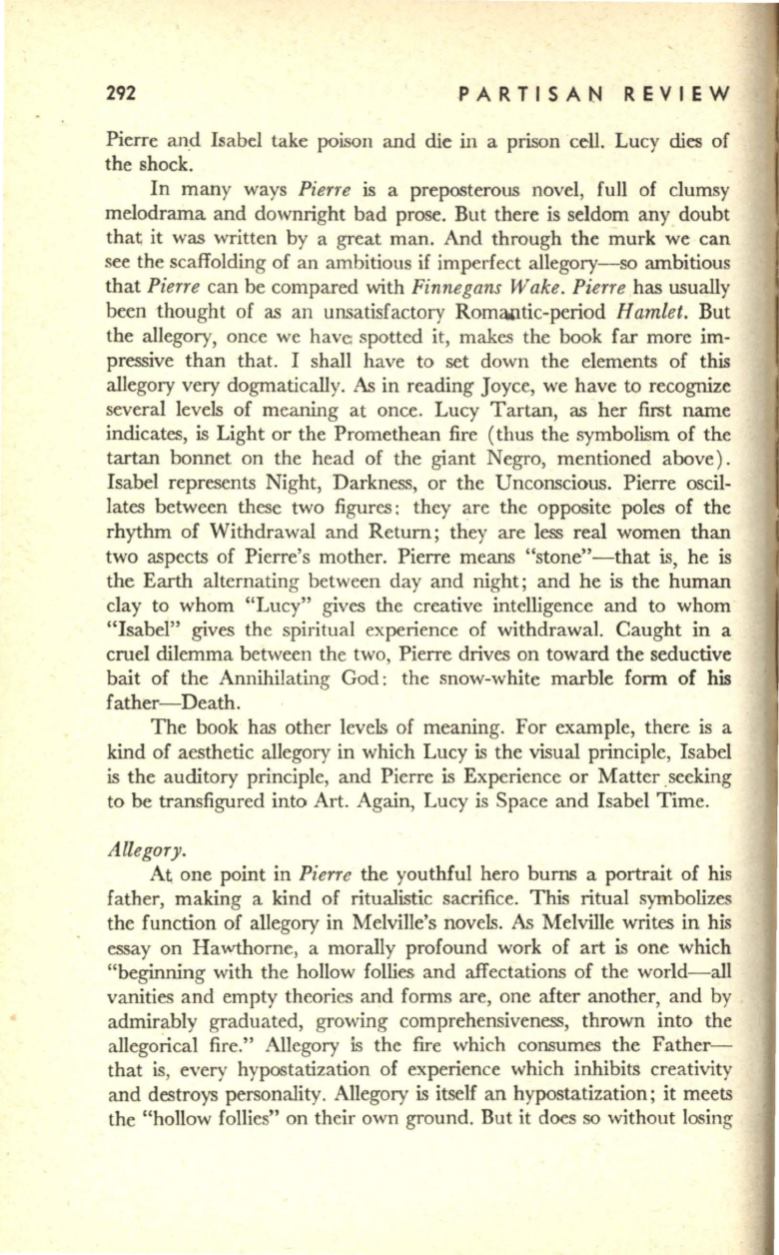
292
PARTISAN REVIEW
Pierre and Isabel take poison and die in a prison cell. Lucy dies of
the shock.
In many ways
Pierre
is a preposterous novel, full of clumsy
melodrama and downright bad prose. But there
is
seldom any doubt
that; it was written by a great man. And through the murk we can
see the scaffolding of an ambitious if imperfect allegory-so ambitious
that
Pierre
can be compared with
Finnegans Wake. Pierre
has usually
been thought of as an unsatisfactory Roma.ntic-period
Hamlet.
But
the allegory, once we have: spotted it, makes the book far more im–
pressive than that. I shall have to set down the elements of this
allegory very dogmatically.
As
in reading Joyce, we have
to
recognize
several levels of meaning at once. Lucy Tartan, as her first name
indicates, is Light or the Promethean fire (thus the symbolism of the
tartan bonnet on the head of the giant Negro, mentioned above) .
Isabel represents Night, Darkness, or the Unconscious. Pierre oscil–
lates between these two figures: they are the opposite poles of the
rhythm of Withdrawal and Return; they are less real women than
two aspects of Pierre's mother. Pierre means "stone"-that
is,
he is
the Earth alternating between day and night; and he
is
the human
clay to whom "Lucy" gives the creative intelligence and to whom
"Isabel" gives the spiritual experience of withdrawal. Caught in a
cruel dilemma between the two, Pierre drives on toward the seductive
bait of the Annihilating God: the snow-white marble form of his
father-Death.
The book has other levels of meaning. For example, there
is
a
kind of aesthetic allegory in which Lucy is the visual principle, Isabel
is the auditory principle, and Pierre
is
Experience or Matter seeking
to be transfigured into Art. Again, Lucy is Space and Isabel Time.
Allegory.
At; one point in
Pierre
the youthful hero burns a portrait of his
father, making a kind of ritualistic sacrifice. This ritual symbolizes
the function of allegory in Melville's novels.
As
Melville writes in his
essay on Hawthorne, a morally profound work of art
is
one which
"beginning with the hollow follies and affectations of the world-all
vanities and empty theories and forms are, one after another, and by
admirably graduated, growing comprehensiveness, thrown into the
allegorical fire." Allegory is the fire which consumes the Father–
that is, every hypostatization of experience which inhibits creativity
and destroys personality. Allegory
is
itself an hypostatization; it meets
the "hollow follies" on their own ground. But it does so without losing


